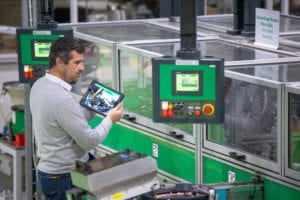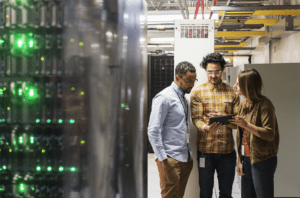Earlier this year, Gartner outlined its top 10 strategic technology trends and many of them center on growing industrial edge data centers investments.
This should not come as a surprise because Gartner has been quite clear that it expects edge requirements to explode in coming years. Santhosh Rao, senior research director at Gartner, predicted last year that, “Currently, around 10% of enterprise-generated data is created and processed outside a traditional centralized data center or cloud. By 2025, Gartner predicts this figure will reach 75%.”
Reviewing the top 10 trends for 2019, as outlined by David Cearley, vice president and Gartner Fellow, it’s easy to see why the investment in the industrial edge continues to grow.

Autonomous things and digital twins
The list started with “autonomous things,” such as robots, drones and vehicles, which all use artificial intelligence to automate functions once performed by humans.
“As autonomous things proliferate, we expect a shift from stand-alone intelligent things to a swarm of collaborative intelligent things, with multiple devices working together, either independently of people or with human input,” Cearley said.
AI, of course, requires considerable computing power. If AI is going to be powering mobile objects like robots, drones and vehicles, that computing power will need to be close to the devices it is controlling – because a round-trip to a cloud-based data center would introduce far too much latency. Hence, we’ll need lots of industrial edge data centers.
Another prediction was for a proliferation of “digital twins,” which Gartner defines as digital representations of real-world entities or systems. “Digital twins will exist for potentially billions of things,” Gartner said, including entire organizations – what Gartner calls DTOs.
“A DTO is a dynamic software model that relies on operational or other data to understand how an organization operationalizes its business model, connects with its current state, deploys resources and responds to changes to deliver expected customer value,” Cearley said. A DTO is a “dynamic software model,” he noted – meaning it’s constantly changing.
Here again, it seems to me like it will take a lot of data to create even a single DTO, or a digital twin of any kind for that matter. And if it’s dynamic, that data will need to be close by, once again fueling the need for edge data centers.
Immersive experiences and smart spaces
Gartner also expected to see technologies such as virtual and augmented reality to change the way people perceive the world, leading to more immersive, “multimodal” user experiences. “The multimodal experience connects people with the digital world across hundreds of edge devices that surround them, including traditional computing devices, wearables, automobiles, environmental sensors and consumer appliances,” Cearley said.
It doesn’t stop there. We’re also going to see “smart spaces,” which Gartner defines as a physical or digital environment in which humans and technology-enabled systems interact in open, connected, coordinated and intelligent ecosystems. Smart spaces are essentially the next step in the evolution of technologies such as smart cities, smart homes and connected factories.
“We believe the market is entering a period of accelerated delivery of robust smart spaces with technology becoming an integral part of our daily lives, whether as employees, customers, consumers, community members or citizens,” Cearley said.
Combine immersive experiences and smart spaces, and you again will be creating demand for a lot of edge compute power to drive all of these real-time applications.
Gartner highlights the “empowered edge”
Indeed, edge computing itself made Gartner’s top 10 list, specifically what it calls the “empowered edge.” Gartner correctly points out that industrial edge computing is being driven largely by Internet of Things applications, which need localized processing as opposed to “centralized cloud servers.”
But Gartner expects that both the cloud and edge “will evolve as complementary models with cloud services being managed as a centralized service executing, not only on centralized servers, but also in distributed servers on-premises and on the edge devices themselves.” Now that’s something to consider: cloud-based services executing in edge data centers and devices.
As 5G technology matures, Gartner says it will help drive that trend, making robust communications between edge data centers and the cloud more widely available.
Meeting the demand for industrial edge data centers
Gartner, as always, provides lots of food for thought with its annual predictions. It’s clear that we’re going to see a steady increase in demand for edge data centers.
We have been keeping an eye on the trend towards edge data centers for years, and we stand ready to help with practical solutions for commercial and industrial applications. Whether it’s our offering of prefabricated, modular data center infrastructure, micro data center solutions, or our numerous partnerships with IT vendors for compute, storage and networking components, we are here to partner with you to help meet your edge data center requirements.



